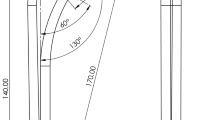Abstract
Total hip arthroplasty is one of the most successful and cost-effective surgical interventions performed in orthopedics. The performance of hip prosthesis depends on factors such as type of material, dimensions, type of contact and stresses induced. The present paper addresses the influence of various material combinations on the contact stress. The metal and ceramic combinations are considered. Normal force due to walking is considered to estimate the contact stresses analytically, using Von Mises stress theory. The various radial clearances between head and liner, obtained by considering different geometrical configurations, are used to calculate contact stresses for all hard-on-hard material combination. The variation of contact stress during natural biological activities, such as walking, sitting, climbing and stumbling, is tabulated and represented graphically. A linear relationship is observed between contact stress and radial clearance. Highest contact stress is observed in ceramic-on-ceramic combination across all activities.


Similar content being viewed by others
References
Kurtz, S., Ong, K., Lau, E., Mowat, F., Halpern, M.: Projections of primary and revision hip and knee arthroplasty in the United States from 2005 to 2030. J. Bone Joint Surg. (2007). https://doi.org/10.2106/JBJS.F.00222
Das, S.S. and Chakraborti, P.: Development of biomaterial for total hip joint replacement. In: IOP Conference (2018). https://doi.org/10.1088/1757-899X/377/1/012177
Gallo, J., Goodman, S.B., Lostak, J., Robert, M.J.: Advantages and disadvantages of ceramic-on-ceramic total hip arthroplasty: a review. Biomed Pap (2012). https://doi.org/10.5507/bp.2012.063
Cross, M.B., Nam, D., Mayman, D.J.: Ideal femoral head size in total hip arthroplasty balances stability and volumetric wear. HSS J. (2012). https://doi.org/10.1007/s11420-012-9287-7
Meng, Q., Lui, F., Fisher, J., Jin, Z.: Contact mechanics and lubrication analyses of ceramic on metal total hip replacement. Tribol. Int. (2012). https://doi.org/10.1016/j.triboint.2012.02.012
Yousif, A.E. and Mossa, H.A.L.: Wear in total artificial hip joints, mechanical and nuclear engineering (2009). https://www.researchgate.net/publication/275971895_Wear_in_Total_Artificial_Hip_Joints
Popov, V.L.: Contact Mechanics and Friction. Springer, Berlin, Heidelberg (2010)
Author information
Authors and Affiliations
Corresponding author
Additional information
Publisher's Note
Springer Nature remains neutral with regard to jurisdictional claims in published maps and institutional affiliations.
Rights and permissions
Springer Nature or its licensor (e.g. a society or other partner) holds exclusive rights to this article under a publishing agreement with the author(s) or other rightsholder(s); author self-archiving of the accepted manuscript version of this article is solely governed by the terms of such publishing agreement and applicable law.
About this article
Cite this article
Mishra, A., Jain, I., Joshi, S. et al. Effect of different biomaterials on maximum contact stress in total hip arthroplasty. Int J Adv Eng Sci Appl Math 15, 167–172 (2023). https://doi.org/10.1007/s12572-023-00342-7
Accepted:
Published:
Issue Date:
DOI: https://doi.org/10.1007/s12572-023-00342-7




